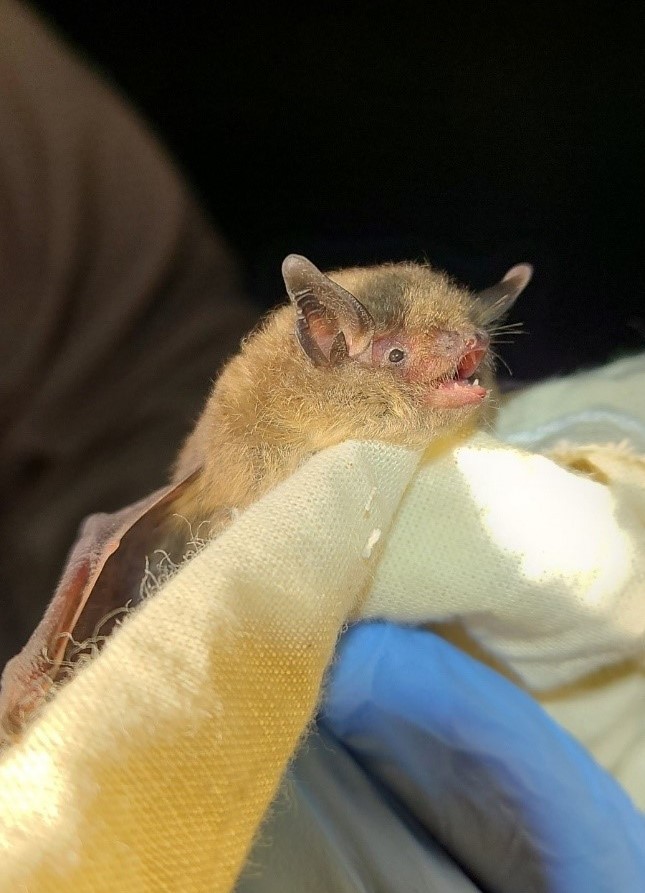Forest Service Monitoring Efforts Locate Indiana Bat Maternity Colony
Release Date: Jul 26, 2021
RUSSELLVILLE, Ark.– July 26, 2021— Ozark-St. Francis National Forest biologists located an Indiana bat maternity colony while conducting monitoring surveys on the Big Piney Ranger District in Newton County, in July.
The discovery is the first time that an Indiana bat maternity colony has been found in the Ozark Region in Arkansas.
Female Indiana bats form social colonies, typically under peeling bark on dead trees, to birth and raise their young. Indiana bat use of caves in the Ozarks for winter hibernation is well known, and some stay in nearby forests through the summer, but all prior evidence indicated that females migrated to large rivers or bottomland forests during the summer to form maternity colonies.
“This exciting discovery offers an opportunity to learn more about the habitat and use of forested lands by this rare species,” said Ozark-St. Francis Forest Supervisor Lori Wood. “We are taking protective steps as identified in the recent Forest Plan Bat Amendment to protect this maternity colony and the surrounding area.”
Biologists net bats and record their calls as they feed at night in order to understand the distribution of different species and understand how they are using forest habitats on the Ozark-St. Francis National Forests. Forest Service biologists work closely with the U.S. Fish and Wildlife Service, Arkansas Game and Fish Commission, and other partners to collect bat monitoring data, which is shared with researchers, partners and biologists to help promote conservation efforts.
Now that a maternity colony has been found, the Ozark-St. Francis National Forests will continue monitoring the bats to determine which trees the bats use. The Forest Service will ensure that maternity trees are protected and natural resource management activities within a quarter mile of those trees are avoided during the time of year that the colony is active in raising their young.
Indiana bats were listed as endangered in 1967 and have recently been impacted by white-nose syndrome, a serious bat disease caused by a fungus.
• The recent Forest Plan Bat Amendment documents are available online at: https://www.fs.usda.gov/project/?project=55628.
• A copy of the 2005 Revised Land and Resources Management Plan (Forest Plan) and associated amendments for the Ozark-St. Francis National Forests are available online at: https://www.fs.usda.gov/main/osfnf/landmanagement/planning
For more information on the Ozark St. Francis National Forests, visit https://www.fs.usda.gov/osfnf/.

Indiana Bat Photo Caption:
Ozark-St. Francis National Forest biologists located an Indiana bat maternity colony while conducting monitoring surveys on the Big Piney Ranger District in Newton County, in July. The discovery is the first time that an Indiana bat maternity colony has been found in the Ozark Region in Arkansas. Photo by Brian Dennis, Environmental Solutions Innovations, Inc.
###
The U.S. Department of Agriculture (USDA) prohibits discrimination in all its programs and activities on the basis of race, color, national origin, age, disability, and where applicable, sex, marital status, familial status, parental status, religion, sexual orientation, genetic information, political beliefs, reprisal, or because all or part of an individual’s income is derived from any public assistance program. (Not all prohibited bases apply to all programs.) Persons with disabilities who require alternative means for communication of program information (Braille, large print, audiotape, etc.) should contact USDA’s TARGET Center at (202) 720-2600 (voice and TDD). To file a complaint of discrimination, write USDA, Director, Office of Civil Rights, 1400 Independence Avenue, S.W., Washington, D.C. 20250-9410, or call (800) 795-3272 (voice) or (202) 720-6382 (TDD). USDA is an equal opportunity provider and employer.